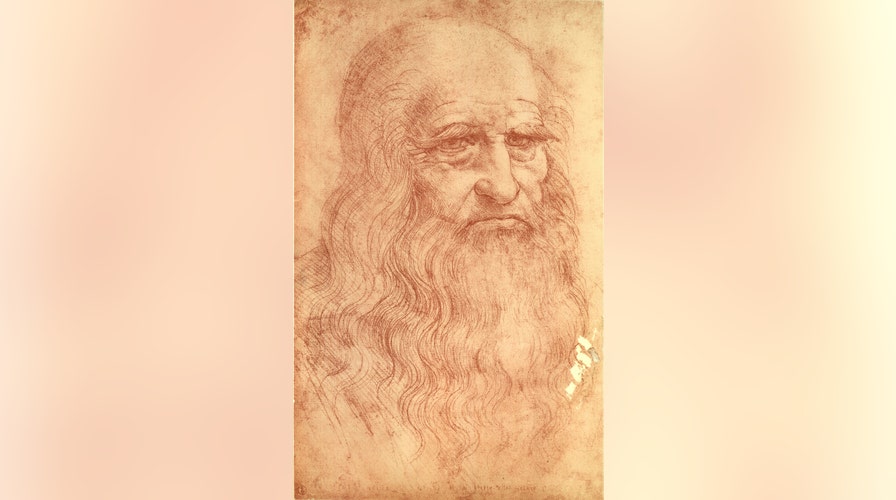Fox News Flash top headlines for Feb. 7
Fox News Flash top headlines are here. Check out what's clicking on Foxnews.com.
Six months after it was discovered that Leonardo da Vinci's "Virgin of the Rocks" painting contained hidden images underneath, a new X-ray scan has revealed a winged angel and the baby Jesus in clearer fashion.
The researchers used a technique on the painting known as macro X-ray fluorescence (MA-XRF) and a new algorithm to interpret the findings of the hidden, older sketches.
“It was like looking for a needle in a haystack, but such a great feeling to see the wings and head finally uncovered," Pier Luigi Dragotti, a professor at the Imperial College London, said in a statement.

The original Infant Christ and winged angel, mapped by scanning for zinc using MA-XRF. (Credit: Imperial College London)
DA VINCI AMBIDEXTROUS, NEW HANDWRITING ANALYSIS SHOWS
The MA-XRF scan looked at chemical elements in the painting, most notably zinc, to aid the researchers and discover the infant Christ and the winged angel. The new algorithm, which let Dragotti automatically process the data from the MA-XRF scans, improved on previous manual methods to provide clearer images.
“Each pixel contained different amounts of each element, within various layers," Dragotti added. "We analyzed each pixel individually before combining them to see all the underdrawings in the painting. This revealed a much sharper image of the angel and baby.”
The discovery of the zinc and the algorithm's ability to interpret it as hidden drawings was paramount to the discovery, Catherine Higgitt, a researcher at the National Gallery in London, added in the statement.

(Credit: Imperial College London)
“Before, we were getting very weak signals from the zinc within the painting due to its overlap with other elements, but the algorithm has given us more confidence in the signals that relate to the underdrawing," Higgitt said.
“It’s been a rewarding experience to learn about and combine our different fields," she added. "The findings could also help us to reach out to more varied and unexpected audiences.”
"The Virgin of the Rocks" is one of three panels that da Vinci was commissioned to produce for an altarpiece in 1483. Fox News previously reported that the hidden images in the work were first discovered in August 2019.

(Credit: Imperial College London)
LEONARDO DA VINCI'S THUMBPRINT DISCOVERED: DRAWING IN QUEEN ELIZABETH'S COLLECTION REVEALS SECRETS
Da Vinci continues to be a source of fascination, more than 500 years after his death. Experts in Italy said in 2018 they had found the earliest surviving work by da Vinci. The small glazed terracotta tile, which bears the date “1471,” is described as a self-portrait of the artist as the Archangel Gabriel.
In January 2019, da Vinci’s thumbprint was discovered in a drawing by the Renaissance Master that is owned by Queen Elizabeth II. The hidden detail, revealed in a book entitled “Leonard da Vinci: A Closer Look,” analyzes 80 of Leonardo’s drawings from the Royal Collection, shedding new light on the famous artist’s craft.
The thumbprint was found on “the cardiovascular system and principal organs of a woman,” an anatomical drawing by Leonardo that dates to around 1509 and 1510.
A study published in May 2019 revealed that he may have had ADHD. Symptoms commonly associated with ADHD include procrastination, an inability to finish tasks and restlessness in both body and mind.

(Credit: Imperial College London)
The famed Italian inventor was considered to have many of these issues, according to several of his biographers and contemporaries. He was "constantly on the go, often jumping from task to task" and like many with the affliction, he slept little and worked tirelessly.
In October 2019, a bridge design that da Vinci created for the Ottoman Empire was cited by experts as possibly his most awe-inspiring work. A recent study also indicates that da Vinci, who was famously left-handed, was ambidextrous.
Da Vinci died May 2, 1519, at the age of 67.
CLICK HERE TO GET THE FOX NEWS APP
Fox News' James Rogers contributed to this report.

